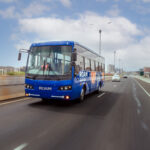Your air taxi is landing!
Your air taxi is landing!
The concept of an electric vertical take-off and landing (eVTOL) aircraft emerged in 2009, when a video of the NASA Puffin eVTOL concept went viral. Fast forward 14 years and it seems the time of air taxis is nigh.
Flying “cars” have moved from the realm of science fiction to a real world alternative for getting people from A to B. At least, they will have in little more than a year. In May, the US Federal Aviation Administration (FAA) even released an updated blueprint for airspace and procedure changes to accommodate future air taxis and other Advanced Air Mobility (AAM) operations.
According to this blueprint AAM operations will begin at a low rate, with air taxis flying much as helicopters do today. They’ll use existing routes and infrastructure such as helipads and early vertiports – a type of airport for vertical take-off and landing (VTOL) aircraft.
“As the number of operations increases, air taxis are expected to fly in corridors between major airports and vertiports in city centres. The complexity of the corridors could increase over time from single one-way paths to routes serving multiple flows of aircraft flying in both directions. Over time, these corridors could link an increasing number of routes between vertiports,” the FAA explains.
Industry players aren’t letting any grass grow under their feet. Chicago’s first air taxi route is being planned by California-based eVTOL developer Archer Aviation and United Airlines. It will run between O’Hare International Airport (ORD) and Vertiport Chicago in the city’s central business district – North America’s largest VTOL aircraft facility.
From there, passengers will be able to travel to and from ORD in Archer’s Midnight aircraft, a five-seater eVTOL production aircraft that can carry four passengers and one pilot for nearly 100km at speeds of up to 241km/h using today’s battery technologies.
The trip will take approximately 10 minutes; a similar trip by car can take upwards of an hour during rush hour traffic.
United and Archer’s goal for its urban air mobility network is to provide residents and visitors in the Chicago Metropolitan Area with a safe, sustainable, low noise, and cost-competitive alternative to ground transportation, beginning in 2025.
The early launch routes will focus on airport to city centre transportation services, which are referred to as “trunk routes”. Once the trunk routes have been established, the next step will be to build out branch routes connecting to surrounding communities.
“Both Archer and United are committed to decarbonising air travel and leveraging innovative technologies to deliver on the promise of the electrification of the aviation industry,” says United Airlines president Michael Leskinen. “Once operational, we’re excited to offer our customers a more sustainable, convenient, and cost-effective mode of transportation during their commutes to the airport.”
As well as these planned routes, there are further developments that are a sign of the times. Joby Aviation – another California-based transport company that is developing eVTOL air taxis – has announced plans to locate its first scaled aircraft production facility in Dayton, Ohio, the birthplace of aviation.
The Wright Brothers, who invented and flew the first powered aircraft, lived and worked in Dayton, opening the first US aeroplane factory there in 1910. The city is also home to Wright-Patterson Air Force Base and the headquarters of the US Air Force Research Laboratories, which has played a key role in supporting Joby’s development.
Joby plans to build a facility capable of delivering up to 500 aircraft per year at the Dayton International Airport. The nearly 60-hectare site has the potential to support significant further growth over time, providing enough land to build more than 600km2 of manufacturing space. Construction of the scaled Ohio facility is expected to start in 2024, while it is expected to come online in 2025.
“We’re building the future of aviation right where it all started, in Dayton, Ohio,” says JoeBen Bevirt, founder and CEO of Joby. “The Wright Brothers harnessed revolutionary technology of their time to open up the skies, and we intend to do the same – this time, bringing quiet and emissions-free flight that we hope will have an equally profound impact on our world.”
Joby’s production aircraft is designed to transport a pilot and four passengers at speeds of up to 320km/h, with a maximum range of 160km. Starting in 2025, the company plans to operate these aircraft as part of aerial ridesharing networks in cities and communities around the world, building on partnerships it has developed with Delta Air Lines and Uber.
The time for air taxis really is nigh!
Published by
Jaco de Klerk
focusmagsa




